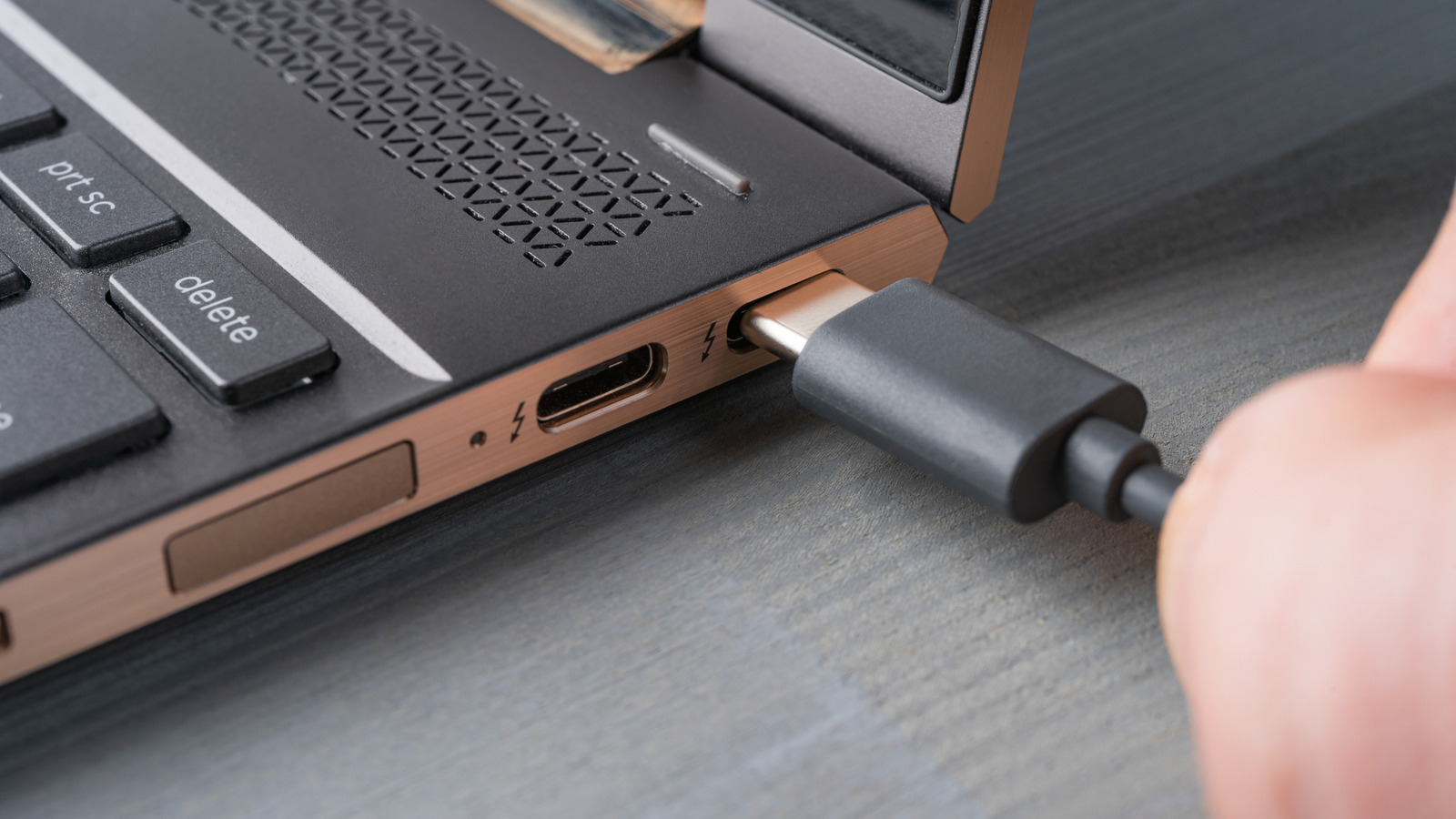
While we’re all collectively on our way to a wireless future, there are plenty of ways cables are still important in our modern world, especially if we don’t have internet access or want a stable connection. In the past, many devices used separate ports and cables for both charging and data transfer. But with time, the arrival of newer technology has made it possible for the USB port to fulfill both these functions effectively. So while many of the ports have come and gone, even the smallest and thinnest laptops are still manufactured with USB ports. Through the years, USBs have remained essential for laptops, especially for users who rely on a lot of peripherals.
Due to active efforts by legislators like those from the European Union, many technology manufacturers have also committed to the standardization of USB-C systems in devices. However, even if a lot of things can be physically plugged into these ports, it doesn’t mean you should. Similar to how there are things you shouldn’t plug into your TV’s USB ports, the same applies for things that go into your laptop ports as well. Plus, your laptop will tend to have a host of other important documents and access to professional and personal information. Because of this, it’s an even bigger target for bad actors or can make your life more difficult if it’s compromised. So, if you want to save yourself a load of hassle, here are some things you should avoid plugging into your USB port.
Most people assume that thumb drives are just for storing things. However, there are actually a ton of other ways you can use USBs both personally and professionally. Apart from being able to boot entire operating systems, they can also be used to store portable programs (and not all of them can be good). In some cases, they can carry everything from viruses to malicious scripts that can take over your laptop or allow bad actors to access it. And for those who work in industries where privacy is crucial, this could spell trouble for more than just yourself. For example, Wired reported how USBs played a pivotal role in Chinese global espionage attempts in 2023.
In general, it’s best to avoid buying secondhand thumb drives entirely, especially if you bought it from a stranger and can’t validate how it was used. If you do decide to take the risk, there are ways to test used USB drives, wherein you can use old laptops instead of your main one. But take note, there are still a lot of things to consider, such as making sure you’re connected to any network that can compromise other devices in your home or office. Alternatively, there are a ton of USBs for a variety of budgets, so you’re spoilt for choice. And if you’re looking for something that can hold a whole decade’s worth of memories, there are large-capacity USBs that even have special features like encryption.
Unlike mobile phones, most laptops are meant to be used firmly on flat surfaces and indoors. Because of this, if you plug in wet or dirty accessories to your laptop, it could end up damaging the USB ports. As with all things in life, some exposure to the elements can’t be helped. Should this happen to you, it’s best to clean your laptop’s USB ports as soon as possible to avoid any problems. Thankfully, you can do this pretty easily with materials you can find in your home. To start with, you can use compressed air or a soft toothbrush to get all the dust that is trapped in its corners. Next, you can use rubbing alcohol with a cotton swab.
Alternatively, if you’ve already spotted signs of corrosion, you can use WD-40 Contact Cleaner, which was specifically developed for cleaning electric components. Should you suspect that the corrosion has already spread to the internal components of your laptop, you may want to consider having it inspected by a professional as soon as possible. If you live a pretty intense lifestyle, there are some military grade laptops out there that are a little more durable than the average computer. Although, as we’ve mentioned before, it’s best to take things marketed as “military grade” with a grain of salt, since the testing processes can be inconsistent. Not to mention, like other devices that also have dust-proof or waterproof ratings, its features can deteriorate with time.
When we first buy our laptops, they often come with chargers that are guaranteed to work with them. Often, they’ve been developed and tested to work as optimally as possible. Not to mention, they’ll definitely be covered by your device manufacturer’s warranty, so if there are any faults beyond your own, you may be able to claim a replacement. However, there are times when we can lose our cables and chargers, or they can also be damaged through normal wear and tear. Plus, it’s important to note that even chargers from official brands aren’t immune to problems, like Toshiba’s AC Adapter recall due to fire risk in 2025. And while most of us would like to simply buy one from the same brand, the reality is that it can sometimes be expensive.
Unfortunately, there are fake cords and chargers of all kinds that come with all sorts of risks for both you and your electronics. In fact, we’ve mentioned before how the UK’s Chartered Trading Standards Institute’s tests concluded that an overwhelming majority of fake Apple chargers fail basic safety tests, especially when it comes to insulation. In many cases, these companies that produce fake charging cables and bricks aren’t accountable to consumers for their product quality and manufacturing consistency. Alternatively, you can opt to buy from reputable brands that are officially recognized by your laptop manufacturer, tested extensively by professionals, and have the necessary safety certifications in the regions where they are selling their products.
Although they use the same kinds of USB cables, some devices are designed to be plugged into AC sockets via charging bricks for a reason. Typically, it’s because they require things like stable current or higher wattage. Unless specifically marketed to be USB-powered gadgets, plenty of devices draw a lot of power that needs to be hooked up to an actual wall plug. In some cases, this can just mean the device won’t work well or charge slower, but in others, it can damage your laptop permanently. Depending on the generation of USB port your laptop has, there is a maximum power that it can supply safely without frying its internal components.
In recent times, laptop models tend to have the latest USB-C Power Delivery (PD) technology, which helps protect your laptop from electricity-related damage and can deliver up to 240W. However, the power ratings can vary between laptop models, and they’re usually tested for charging and not necessarily running external devices. Not to mention, they often require particular things like a cable and a driver support that can handle it, such as with external GPUs. As for professional use, it’s possible that there are portable versions of more powerful tools made to work with your laptop’s USB port, but they usually have reduced capacity or features. For example, while some smaller audio interfaces like the Focusrite Scarlette Solo 3rd Gen can be plugged into your laptop, the brand’s higher end Red Range requires an AC connection.
In a world where many manufacturers value portability, laptops are being released with increasingly fewer ports. For example, the 13-inch M4 MacBook Air only has two USB-C ports, which may be enough for the average user who only needs it for browsing, but can introduce some challenges for people who rely on peripherals for their work flows. Knowing this, it’s no wonder that Apple has released its own $69 USB-C Digital AV Multiport Adapter, but it does lack some ports that many people may need for professional use, like SD card slots. Thankfully, many third-party manufacturers designed USB-C hubs with a slew of ports for laptops, which fall under two categories: unpowered or powered. The main difference is that the former rely on just your laptop’s USB port, while the latter comes with an AC plug.
If you’re only planning to plug in one or two low-powered peripherals, like a USB drive or keyboard, Anker shares that an unpowered USB hub is more than enough. However, for people working with heavy-duty data transfers, it shares that you might need a powered USB hub that uses an external power source. Although, they do tend to be more expensive, since brands need to factor in additional technology like voltage protection. This means that if you plug multiple devices to your unpowered USB hub, it’s possible that it draws too much power. Anker cautions that off-brand USB hubs can also damage your device for the same reasons.



